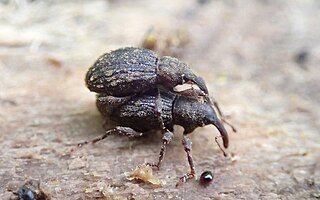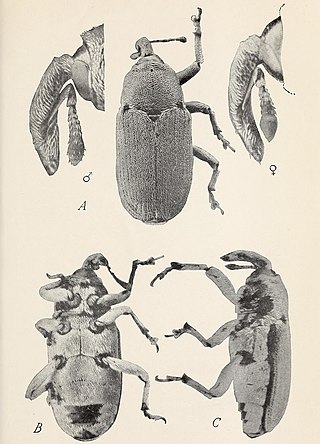Trichobaris trinotata, commonly known as the "Potato stalk borer", is a species of weevil in the family Curculionidae. It is found in North America where it is a pest of potato plants, the larvae tunnelling inside their stems.
Sphenophorus maidis, or maize billbug, is a species of beetles in the family Curculionidae. It is found in North America.
Sphenophorus subulatus is a species of beetles in the family Curculionidae. It is found in North America.

Sthereus is a genus of beetles in the family Curculionidae. There are at least 4 described species in Sthereus.
Pseudopityophthorus is a genus of typical bark beetles in the family Curculionidae. There are about 11 described species in Pseudopityophthorus.
Macrorhoptus is a genus of beetles in the family Curculionidae. There are about 6 described species in Macrorhoptus.
Pheloconus hispidus is a species of beetle in the family Curculionidae. It is found in North America.
Conotrachelus nivosus is a species of beetle in the family Curculionidae. It is found in North America.
Conophthorus edulis, the pinon cone beetle, is a species of typical bark beetle in the family Curculionidae. It is found in North America.
Monarthrum is a genus of typical bark beetles in the family Curculionidae. There are about 5 described species in Monarthrum.

Trichobaris mucorea, the tobacco stalk borer, is a species of flower weevil in the family Curculionidae. It is found in North America.
Phloeosinus vandykei is a species of crenulate bark beetle in the family Curculionidae. It is found in North America.

Phloeosinus is a genus of cedar bark beetles in the family Curculionidae. There are at least 20 described species in Phloeosinus.
Sphenophorus germari is a species in the family Curculionidae. It is found in North America.
Sphenophorus callosus, the southern corn billbug, is a species of snout or bark beetle in the family Curculionidae. It is found in North America.
Sphenophorus pontederiae is a species of snout or bark beetle in the family Curculionidae. It is found in North America.

Cylindrocopturus quercus is a species of Zygopini in the family Curculionidae. It is found in North America.
Phloeosinus dentatus is a species of crenulate bark beetle in the family Curculionidae. It is found in North America.
Cylindrocopturus adspersus, the sunflower stem weevil, is a species of true weevil in the beetle family Curculionidae. It is found in North America, where the larvae tunnel in the stems of wild and cultivated sunflower plants.

Cosmopolites sordidus, commonly known as the banana root borer, banana borer, or banana weevil, is a species of weevil in the family Curculionidae. It is a pest of banana cultivation and has a cosmopolitan distribution, being found in all parts of the world in which bananas are grown. It is considered the most serious insect pest of bananas.





